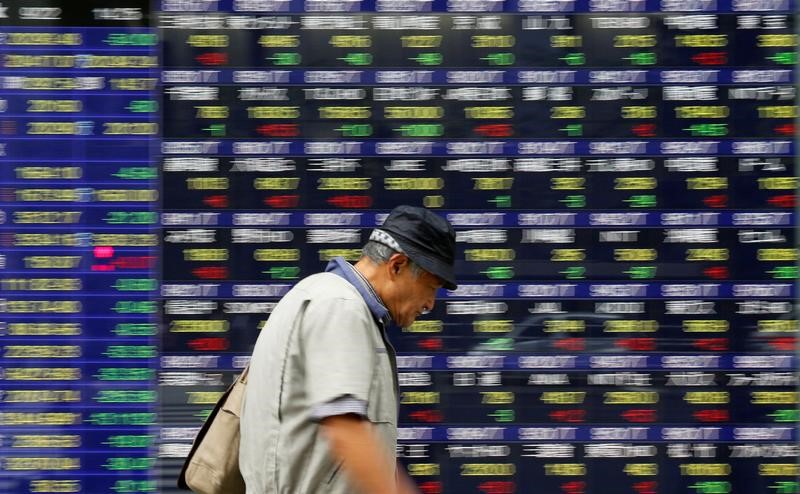A man walks past an electronic stock quotation board outside a brokerage in Tokyo, Japan, September 22, 2017. REUTERS/Toru Hanai
By Wayne Cole
SYDNEY (Reuters) – Asian stocks dipped on Monday as investors braced for a bevy of earnings from the world’s largest corporations, while keeping a wary eye on U.S. bond yields as they approach peaks that have triggered market spasms in the past.
Traders were also anxiously awaiting surveys on global manufacturing for April to see if economic softness in the first quarter was just a passing phase linked to poor weather and the Lunar New Year holidays.
The first reading from Japan was tentatively upbeat with its PMI firming to 53.3 in April as output and domestic demand picked up.
On the geopolitical front, U.S. President Donald Trump said on Sunday the North Korean nuclear crisis was a long way from being resolved, striking a cautious note a day after the North pledged to end its nuclear tests.
Oil prices edged down in early trade but were not far from their highest since late 2014. The market had wobbled on Friday when Trump tweeted criticism of OPEC’s role in pushing up global prices, but quickly steadied.
Brent crude oil futures
In stock markets, MSCI’s broadest index of Asia-Pacific shares outside Japan <.MIAPJ0000PUS> fell 0.4 percent, with South Korea <.KS11> off 0.3 percent.
Japan’s Nikkei <.N225> also eased 0.3 percent as tech stocks continued to struggle with a warning on waning demand for mobile phones.
E-Mini futures for the S&P 500
Rising bond yields had pressured Wall Street on Friday, though the S&P 500 <.SPX> still managed to end the week with a slight gain.
More than 180 companies in the S&P 500 are due to report results this week including Amazon, Alphabet, Facebook, Microsoft, Boeing and Chevron.
THE 3 PCT BARRIER
The spike in oil has driven up both market expectations of future inflation
Yields on 10-year Treasuries
The last time yields neared this number in 2013 it rocked risk appetite and sent stocks sliding.
“Another $5/barrel increase in oil will be enough for U.S. 10-year yields to threaten 3 percent. Oil is now at the cusp of levels where higher prices will spark greater FX and broader asset market volatility,” said Deutsche Bank’s macro strategist, Alan Ruskin.
Traditionally the dollar had a slight negative correlation with oil, mostly because the dominant causation goes from dollar weakness to rising oil prices, he added.
“If oil helps push the 10 year yield into new terrain for this cycle, this will play at least mildly USD positive in a change of correlation.”
Indeed, dealers cited widening yield differentials for the dollar’s broad rally on Friday.
The currency was last at 107.77 yen
The dollar index edged up to 90.369
The euro was easier at $1.2276
Investors are awaiting the European Central Bank’s policy meeting on Thursday amid talk policy makers feel it is still too early to announce a timetable for winding down its bond buying.
ECB chief Mario Draghi on Friday said he was confident that the inflation outlook has picked up, but uncertainties “warrant patience, persistence and prudence.”
(Editing by Sam Holmes and Kim Coghill)
Copyright 2018 Thomson Reuters. Click for Restrictions.



